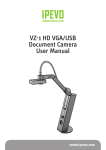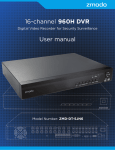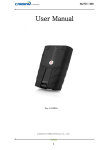Download KAIPCHDSLVA User Manual
Transcript
.$,3&+'6/9$ USER MANUAL Thank you for choosing to purchase and use our IP camera products. This IP monitoring product is an integrated IP network camera which has been designed for network video surveillance. High performance, monolithic SOC chip is utilized as a media processor which integrates video capture, compression, and transmission. Standard H.264 main profile encoding algorithms ensure clear and smooth video transmission. A n embedded web server allows the user to view real-time footage and remotely control the camera via IE web browser. This IP camera is well-suited for home and small businesses, as well as any situation which needs to apply remote network transmission and remote network control. It's easy to install and operate. Product Versions The content in this manual may be different from the product version you are using. If you meet any problems which can't be solved according to this manual, please contact the Kogan customer support team for further information. The content in this manual will be updated when necessary. Kogan reserves the right to update this manual without notice. Intended Reader This manual is intended for the following personnel: Systems planner Onsite tech-support and maintenance personnel Administrator for system installation, configuration and maintenance Users for business operation on product functions Personal home users Terms in this Manual IP Camera, or IPC in this manual, means network camera Click: Click with left button of mouse. Double-click: Rapidly click the left mouse button twice. Right-click: Click with the right button of mouse. The [ ] symbol indicates the windows name, menu name, or data table; such as [Download Address]. Contents Chapter 1 Product Introduction......................................................................................................... 3 1.1 Brief Introduction..................................................................................................................... 3 1.2 Main Features.......................................................................................................................... 3 1.3 Installation Statement.............................................................................................................. 4 1.4 Network IP Camera Connection.............................................................................................. 4 Chapter 2 Access to IP camera on iOS and Android Device .............................................................................................................................................................. 5 2.1 Access to IP Camera on iOS Device....................................................................................... 5 2.1.1 Software Installation...................................................................................................... 5 2.1.2 Launch Zmodo Zsight................................................................................................... 5 2.1.3 Device Management..................................................................................................... 6 2.1.4 Video Play................................................................................................................... 11 2.1.5 Two-way Audio............................................................................................................ 13 2.1.6 About........................................................................................................................... 15 2.2 Access to IP Camera on Android Device............................................................................... 15 2.2.1 Software Installation.................................................................................................... 16 2.2.2 Launch Zmodo Zsight................................................................................................. 16 1 2.2.3 Device Management................................................................................................... 17 2.2.4 Video Play................................................................................................................... 23 ............................................................................................................................................. 24 2.2.5 Two-way Audio............................................................................................................ 25 2.2.6 About........................................................................................................................... 27 Chapter 3 Access to IP camera on Zviewer PC.............................................................................. 28 3.1 Installation and Uninstallation................................................................................................ 28 3.1.1 Operating Environment............................................................................................... 28 3.1.2 Zviewer Installation..................................................................................................... 28 3.1.3 Zviewer Uninstallation................................................................................................. 31 3.2 Operation and Use................................................................................................................ 31 3.2.1 User Login................................................................................................................... 31 3.2.2 Main Interface of Zviewer............................................................................................ 32 .................................................................................................................................................... 34 3.3 Device Management.............................................................................................................. 34 3.3.1 Add Device.................................................................................................................. 34 3.3.2 Edit Device.................................................................................................................. 40 3.3.3 Delete Device.............................................................................................................. 42 Figure 29 .................................................................................................................................................... 43 3.4 Video Browsing...................................................................................................................... 44 3.4.1 Open the Video........................................................................................................... 44 3.4.2 Close the Video........................................................................................................... 45 3.4.3 Video Display Screen.................................................................................................. 46 3.4.4 Two-way Audio............................................................................................................ 48 3.4.5 Screenshot.................................................................................................................. 49 3.5 Record Settings..................................................................................................................... 50 3.5.1 Video Storage Setting................................................................................................. 50 3.5.2 Recording Schedule Setting........................................................................................ 51 3.5.3 Recording Schedule Search....................................................................................... 53 3.6 Video Playback...................................................................................................................... 54 3.6.1 Playback Interface....................................................................................................... 54 3.6.2 Playback Search......................................................................................................... 55 3.6.3 Playback Control......................................................................................................... 55 3.7 User Management................................................................................................................. 56 3.7.1 Add User..................................................................................................................... 57 3.7.2 Edit User..................................................................................................................... 58 3.7.3 Delete User................................................................................................................. 59 3.8 Device Settings...................................................................................................................... 60 3.8.1 System Information..................................................................................................... 61 3.8.2 System Settings.......................................................................................................... 61 3.8.3 Network Parameters Settings..................................................................................... 63 3.8.4 Video Settings............................................................................................................. 69 3.8.5 Storage Settings......................................................................................................... 71 ............................................................................................................................................. 72 3.8.6 Alarm Settings............................................................................................................. 72 Chapter 4 Access to IP camera on Internet Explorer..................................................................... 74 4.1 Log In.................................................................................................................................... 74 4.1.1 Set Security Levels..................................................................................................... 74 4.1.2 Network Configuration................................................................................................. 74 4.1.3 Wi-Fi Configuration..................................................................................................... 76 4.1.4 Login........................................................................................................................... 77 4.2 Preview.................................................................................................................................. 78 4.3 Two –way Audio..................................................................................................................... 80 4.4 Playback and Download........................................................................................................ 81 4.5 Local Configuration................................................................................................................ 83 4.6 Remote Configuration............................................................................................................ 84 4.6.1 Video Settings............................................................................................................. 84 4.6.2 Network Parameters Settings..................................................................................... 87 4.6.3 Alarm Settings............................................................................................................. 96 4.6.4 Alarm Settings ............................................................................................................ 98 4.6.5 System Information..................................................................................................... 99 4.6.6 Advanced Settings.................................................................................................... 101 Chapter 5 IP Camera Specification................................................................................................ 104 Chapter 1 Product Introduction 1.1 Brief Introduction This wireless network camera combines a 720P Color CMOS Image Sensor and H.264 Video Compression. It also supports SD card recording & playback. This allows the camera to be small in size and extremely reliable. Figure 1 1.2 Main Features Using H.264’s advanced video compression standards, the camera is capable of high compression rates and flexible operation. 720P Colour Sensor provides fluid motion video with high-quality colour. Build-in web server supports access via Internet Explorer. Support two-way audio. Support day & night viewing, night vision up to 30ft. Support smartphone live view by scanning a QR code. Support SD card recording & playback Support multiple user simultaneously, multi-level management ensures high system security. Support motion detection alarm (area, sensitivity configurable) and e-mail alert function. Support automatic recovery functions when the system temporarily loses internet connection. Support auto white balance & backlight compensation. Support PPPoE, DDNS, LAN, and Internet (ADSL, Cable Modem). 3 1.3 Installation Statement During installation and operation, please pay attention to the following items: 1. When you receive the package product, please check the equipment and accessories according to the packing list inside the shipping box. 2. Before installing the system, please carefully read this manual. 3. When you install the IP Camera, please make sure that it is not plugged into a power source. 4. Check the voltage of the power source to prevent damaging the device. The correct voltage is 12V DC and 1A. Installation Environment: Please do not use the camera in an environment that has high humidity, high temperatures or extreme changes in temperature. Make sure the camera is installed in a location with good ventilation. Do not install the camera in an area that is subject to violent vibrations. 1.4 Network IP Camera Connection Figure 2 This user manual will mainly introduce three methods to access IP Camera: First Method: Access to IP Camera on iOS and Android Device Second Method: Access to IP Camera on Zviewer PC Third Method: Access to IP Camera on Internet Explorer Chapter 2 Access to IP camera on iOS and Android Device 2.1 Access to IP Camera on iOS Device 2.1.1 Software Installation 2.1.1.1 Environmental Requirements Hardware: iPhone v4.3 up or iPod touch System: iOS 4.3 or up 2.1.1.2 Installation Steps Download and install the free Zmodo Zsight software from iTunes App Store or download Zsigh for iOS from http://www.zmodo.com/support-software/. 2.1.2 Launch Zmodo Zsight Note 1. Open the program called IPCSearch (Download from http://www.zmodo.com/support-software/) Click the [Refresh] button on the upper right side of the IPCSearch program. Your IP Camera should appear in the list of items if your IP Camera is successfully connected to the same router as your PC is connected to. You can find IP Camera’s IP address from IPCSearch (as Figure 3). Figure 3 2. Before launching Zsight, please make sure that your iOS device is connected to the same Wi-Fi internet connection that the ZMODO IP Camera is connected to. Also, make sure to enable DHCP and UPNP on the router that the IP Camera is connected to. Router’s wireless authentication mode cannot be set “WEP Encrypted”. Tap the Zsight icon (as Figure 4 overleaf) from the home screen to open Zmodo Zsight, the device will automatically enter the “Device List” section (as Figure 5 overleaf). 5 Figure 4 Figure 5 2.1.3 Device Management 2.1.3.1 Add a Device The user may add a new IP Camera either by scanning the QR Code on the IP Camera or by selecting the IP Camera from a list of local network devices. ▲Method One: Scan to Add 1. From the List tab, click the [+] icon, then tap the QR Code icon to enable the scan mode (as Figure 6). Figure 6 2. Aim the highlighted box at the QR Code on the back of your IP Camera, Zsight will automatically scan and add the IP Camera to the Device List when the QR Code is successfully read. 3. After scanning the camera, Zsight will open the Wi-Fi Connection Interface (as Figure 7 ). Figure 7 4. Select the Wi-Fi connection that you wish to connect your IP camera to, enter the Wi-Fi password, and select [Save] (as Figure 8). Figure 8 7 5. Click [Next], enter the default password”111111”, and click [Done] to add the devices ( as Figure 9). Now disconnect the network cable and place the camera anywhere within the Wi-Fi signal range. Figure 9 ▲Method Two: Manual Add 1. Click [Discovery], this will take you to the “Discovery” section. Click [Refresh], and your phone will automatically search all local devices, then click on the 10-digit Device ID (found from the label on the back body of the IP Camera) to add this camera to Zsight (as Figure 10). Figure 10 2. After selecting the camera, Zsight will open the Wi-Fi Connection Interface (as Figure 11). Figure 11 3. Select the Wi-Fi connection that you wish to connect your IP camera to, enter the Wi-Fi password, and select [Save] (as Figure 12). Figure 12 9 4. Click [Next], enter the default password”111111”, and click [Done] to add the devices (as Figure 13). Now disconnect the network cable and place the camera anywhere within the Wi-Fi signal range. Figure 13 2.1.3.2 Edit a Device From the List Menu, click Figure 14). to edit the device info, click [Done] to save or [Cancel] to cancel (as Figure 14 2.1.3.3 Delete a Device Click and drag from right-to-left the device that you wish to delete, this will display the “Delete Box.” Click [Delete], then click [OK] to confirm delete (as Figure 15). Figure 15 2.1.4 Video Play 1. Select the device from the List Menu on your mobile device, and you will be able to see the video stream (as Figure 16). Figure 16 11 2. If this is the first time using the default password to connect video, you will be prompted to change the default password, click [Later] to change password later (as Figure 17). Figure 17 3. Click [Yes] to change password, enter the new password, and click [Save] when finished. (as Figure 18). Figure 18 4. Switch between Portrait and Landscape views by turning your phone horizontally or vertically (as Figure 19). Figure 19 2.1.5 Two-way Audio 1. Under real-time video, “Voice” and “Talkback” functions are turned off by default (as Figure 20). Figure 20 2. Click [ ] to enable voice function, the voice icon will turn green, now you can hear device sound from your mobile device (as Figure 21, overleaf). 13 Figure 21 3. Click [ ] to enable talkback function, the talkback icon will turn green, now IP Camera and mobile device can realize two-way voice talkback. With exclusive mode, when a mobile device enables its talkback function, other mobile device can not initiate this function (as Figure 22). Figure 22 4. If only talkback function is enabled, IP Camera can receive sound from mobile device, while mobile device can not receive sound from IP Camera (as Figure 23). Figure 23 2.1.6 About Click [About], this will take you to the “About” section (as Figure 24). Figure 24 15 2.2 Access to IP Camera on Android Device 2.2.1 Software Installation 2.2.1.1 Environmental Requirements Hardware: Android Phone or Android Player System: Android v2.3 up 2.2.1.2 Installation Steps Download and install the free Zmodo Zsight software from Google Play or download Zsigh for Android from http://www.zmodo.com/support-software/. 2.2.2 Launch Zmodo Zsight Note 1. Open the program called IPCSearch (Download from http://www.zmodo.com/support-software/) Click the [Refresh] button on the upper right side of the IPCSearch program. Your IP Camera should appear in the list of items if your IP Camera is successfully connected to the same router as your PC is connected to. You can find IP Camera’s IP address from IPCSearch (as Figure 25). Figure 25 2. Before launching Zsight, please make sure that your Android device is connected to the same WiFi internet connection that the ZMODO IP Camera is connected to. Also, make sure to enable DHCP and UPNP on the router that the IP Camera is connected to. Router’s wireless authentication mode cannot be set “WEP Encrypted”. Tap the Zsight icon (as Figure 26, overleaf) from the home screen to open Zmodo Zsight, the device will automatically enter the “Device List” section (as Figure 27, overleaf). Figure 26 Figure 27 2.2.3 Device Management 2.2.3.1 Add a Device The user may add a new IP Camera either by scanning the QR Code on the IP Camera or by selecting the IP Camera from a list of local network devices. ▲Method One: Scan to Add 1. From the List tab, click the [Add] icon, then tap the QR Code icon to enable the scan mode (as Figure 28). Figure 28 2. Aim the highlighted box at the QR Code on the back of your IP Camera, Zsight will automatically scan and add the IP Camera to the Device List when the QR Code is successfully read. 17 3. After scanning the camera, Zsight will open the Wi-Fi Connection Interface (as Figure 29). Figure 29 4. Select the Wi-Fi connection that you wish to connect your IP camera to, enter the Wi-Fi password, and select [Save] (as Figure 30). Figure 30 5. Click [Next], enter the default password”111111”, and click [Save] to add the devices (as Figure 31). Now disconnect the network cable and place the camera anywhere within the Wi-Fi signal range. Figure 31 ▲Method Two: Manual Add 1. Click [Discovery], this will take you to the “Discovery” section. Click [Refresh], and your phone will automatically search all local devices, then click on the 10-digit Device ID (found from the label on the back body of the IP Camera) to add this camera to Zsight (as Figure 32). Figure 32 19 2. After selecting the camera, Zsight will open the Wi-Fi Connection Interface (as Figure 33). Figure 33 3. Select the Wi-Fi connection that you wish to connect your IP camera to, enter the Wi-Fi password, and select [Save] (as Figure 34). Figure 34 4. Click [Next], enter the default password”111111”, and click [Save] to add the devices (as Figure 35). Now disconnect the network cable and place the camera anywhere within the Wi-Fi signal range. Figure 35 2.2.3.2 Edit a Device 1. Select the device that you wish to configure and press it for several seconds until the Menu Box is displayed (as Figure 36). Figure 36 21 2. Click [Edit], this will take you to the “Edit” section. Edit device information, then click [Save] to save or [Back] to cancel (as Figure 37). Figure 37 2.2.3.3 Delete a Device Select the device that you wish to delete and press it for several seconds until the Menu Box is displayed (as Figure 36). Click [Delete], then click [OK] to confirm delete; or [Cancel] to cancel the delete (as Figure 38). Figure 38 2.2.4 Video Play 1. Select the device from the List Menu on your mobile device, and you will be able to see the video stream (as Figure 39). Figure 39 2. If this is the first time using the default password to connect video, you will be prompted to change the default password, click [Later] to change password later (as Figure 40). Figure 40 23 3. Click [Yes] to change password, enter the new password, and click [Save] when finished (as Figure 41). Figure 41 4. Switch between Portrait and Landscape views by turning your phone horizontally or vertically (as Figure 42). Figure 42 2.2.5 Two-way Audio 1. Under real-time video, “Voice” and “Talkback” functions are turned off by default (as Figure 43). Figure 43 2. Click [ ] to enable voice function, the voice icon will turn green, now you can hear device sound from your mobile device (as Figure 44). Figure 44 25 3. Click [ ] to enable talkback function, the talkback icon will turn green, now IP Camera and mobile device can realize two-way voice talkback. With exclusive mode, when a mobile device enables its talkback function, other mobile device can not initiate this function (as Figure 45). Figure 45 4. If only talkback function is enabled, IP Camera can receive sound from mobile device, while mobile device can not receive sound from IP Camera (as Figure 46). Figure 46 2.2.6 About Click [About], this will take you to the “About” section (as Figure 47). Figure 47 27 Chapter 3 Access to IP camera on Zviewer PC 3.1 Installation and Uninstallation 3.1.1 Operating Environment Operating Environment Software Subitem Description Operating system Minimum configuration Hardware Recommended configuration Windows XP/ Vista/Win7/Window8 1.6 GHz CPU, 1G memory, 1024x768 display resolution, 100G HD 2.2 GHz or faster CPU, 2G or more memory, 1280x1024 display resolution, 500G or larger HD 3.1.2 Zviewer Installation 1. Download “zviewer for windows” software from “http://www.zmodo.com/ support-software/”, and double click “Setup” for the Zviewer installation (as Figure 1). Figure 1 2. Click [Next], select the installation path, then click [Next] (as Figure 2). Figure 2 3. Select the start menu folder, then click [Next] (as Figure 3). Figure 3 4. You will be prompted to choose whether to create shortcut on your desktop, click [Create a desktop icon], then click [Next] (as Figure 4). Figure 4 29 5. Click [Install] to install Zviewer on your PC (as Figure 5). Figure 5 6. Click [Finish] to finish the installation of Zviewer (as Figure 6). Figure 6 3.1.3 Zviewer Uninstallation Click [Start]-[All Programs]-[ZMODO]-[Zviewer]-[Uninstall Zviewer], and uninstall Zviewer as prompted (as Figure 7 and Figure 8). Figure 7 Figure 8 3.2 Operation and Use 3.2.1 User Login Launch Zviewer on your PC, if this is the first time to login, enter the default user name “ admin” and the default password “111111”, then click [Login] (as Figure 9). If check the box “Remember me”, you can have the system remember the user name and password, so that you do not need to type it each time, only click [Login] to login Zviewer. Figure 9 31 3.2.2 Main Interface of Zviewer Zviewer main interface is as follows: Figure 10 Main Interface Function Area No. Description Device list Toolbar PTZ control panel Image quality control panel Device List: Display all added devices, including IPC and NVR. Toolbar Function Icon Description 1 channel Mode: Click for 1 channel video display layout 4-channel Mode: Click for 4-channel video display layout 8-channel Mode: Click for 8-channel video display layout Full Screen Mode: Click for full-screen display at any layout Talkback: Click to enable talkback function Voice: Click to enable voice function PTZ Control Panel Function Icon Description Control device to move up/down Control device to move left/right Pause device Focal length adjustment Brightness adjustment Zoom in/out Reset Set preset Move to preset position Set interval time Patrol route 33 Image Quality Control Panel Function Icon Brightness Contrast Description Adjust the brightness Adjust the contrast Saturation Adjust the saturation Reset Adjust the color (black and white) Color Adjust the orientation (normal, flip, mirror, flip plus mirror) Orientation Voltage Adjust the voltage Restore default settings 3.3 Device Management 3.3.1 Add Device The first time to successfully launch Zviewer, system will automatically enters to the “Discovery” interface, to search and add device (as Figure 11). Figure 11 3.3.1.1 Auto Search to Add a Device 1. Select the type of to-be-searched devices (IPC, NVR or ALL), default type is ALL. Click [Search] on left bottom to search device (as Figure 12). Figure 12 2. Click [Add All] on the bottom right of the screen to add your devices, you will be prompted with “Add devices to system successfully” after successfully adding them (as Figure 13). Figure 13 35 3.3.1.2 Manually Add a Device There are mainly two methods to manually add a device: ▲First Method: Add a device by its IP 1. Find [ ] “Setting”, and click [Device Management]. Right click in the blank area on the right, then click [Add] (as Figure 14). Figure 14 Or find [ ] “Live”, right click [Devices], then click [Add Device] (as Figure 15). Figure 15 2. After either of the above operation, you will enter to “New Device Add Wizard” section (as Figure 16). [Device by ID] Keep uncheck [Name] Enter the device name [Type] Select device type (IPC or NVR) After the settings are finished, click [Next]. Figure 16 3. System shall automatically identify and add the values of “Port”, “Max Channel”, “Login” and “Password”, enter device IP, then click [Finish] (as Figure 17). [IP] Enter device IP (searched by IPCSearch, please check Section 2.1.2 for more information on IPCSearch) [Max Channel] Quantity of channels of the device [Login] User name of the device, default is “admin” [Password] Login password, default is “111111” Figure 17 37 4. You will be prompted with “Add Device Successfully” after successfully adding them (as Figure 18). Figure 18 ▲Second Method: Add a device by its ID 1. Find [ ] “Setting”, and click [Device Management]. Right click in the blank area on the right, then click [Add] (as Figure 19). Figure 19 Or find [ ] “Live”, right click [Devices], then click [Add Device] (as Figure 20). Figure 20 2. After either of the above operation, you will enter to “New Device Add Wizard” section (as Figure 21). Click [Device by ID], click on the 10-digit Device ID (found from the label on the back body of the IP Camera) and click [Next]. Figure 21 39 3. System shall automatically identify and add the values of “Max Channel”, “Login” and “Password”, then click [Finish]. You will be prompted with “Add Device Successfully” after successfully adding it (as Figure 22). [Max Channel] Quantity of channels of the device [Login] User name of the device, default is “admin” [Password] Login password, default is “111111” Figure 22 3.3.2 Edit Device 1. Find [ ] “Setting”, and click [Device Management]. Right click in the blank area on the right, then click [Edit] (as Figure 23). Figure 23 Or find [ ] “Live”, right click a device from the Device List, then click [Edit Device] (as Figure 24). Figure 24 2. You will enter to “Edit Device Add Wizard” section (as Figure 25), you can edit device name, then click [Next]. Figure 25 41 3. You can modify device information (IP, Port, Max Channel, User Name and Password), then click [Finish] (as Figure 26). Figure 26 3.3.3 Delete Device 1. Find [ ] “Setting”, and click [Device Management]. Right click in the blank area on the right, then click [Delete] (as Figure 27). Figure 27 Or find [ ] “Live”, right click a device from the Device List, then click [Delete Device]. 2. This will take you to the “Delete Device” section (as Figure 29). Click [Yes] to confirm delete. Click [No] to cancel delete. Figure 29 43 3.4 Video Browsing 3.4.1 Open the Video After devices are successfully added, find [ three methods to open the video. ], this will take you to “Live” interface, there are mainly ▲First Method: Double-click a device from the Device List on the left to the Play Window. ▲Second Method: Drag a device from the Device List on the left to the window to the Play Window. ▲Third Method: Right click a device name from the Device List, then click [Open Video], the video stream will display in the available window (as Figure 30). Figure 30 For your safety, you will be prompted to change the default password. You can choose to change it now or later (as Figure 31 Figure 31 3.4.2 Close the Video There are mainly two methods to close the video. ▲First Method: Right click a device name from the Device List, and then click [Close] to close the video (as Figure 32). Figure 32 ▲ Second Method: Click [×] at the top right corner of the open video window to close it (as Figure 33). Figure 33 45 3.4.3 Video Display Screen ▲ Click [ ] for one channel video display layout (as Figure 34). Figure 34 ▲ Click [ ] for 4-channel video display layout (as Figure 35). Figure 35 ▲ Click [ ] for 8-channel video display layout (as Figure 36). Figure 36 ▲ Click [ ] for full-screen display at any layout, click [ESC] to exit full screen mode. Note 1. Default video display screen is 4-channel display layout. 2. Under live video mode, double click any video at any layout for full-screen display, then click [ESC] or double click to exit full screen mode. 47 3.4.4 Two-way Audio 1. Under real-time video, “Voice” and “Talkback” functions are turned off by default. Click a device from the Device List. 2. Click [ ] to enable voice function, the voice icon will change to [ ]. 3. Click [ ] to enable talkback function, the talkback icon will turn green [ ]. 4. Now you can speak and hear through the IP camera using a PC with two headsets (one in PC, the other in IP Camera), (as Figure 37). Figure 37 Note With exclusive mode, when Zviewer enables a device’s talkback and voice function, other device’s voice function can be initiated, while talkback function cannot be initiated. 3.4.5 Screenshot 1. Select screenshot storage path: Find [ ] “Setting”, click [Local Settings], then click […] to set screenshot storage path, default storage path is “C:\Program Files\ZMODO\ZViewer\ZviewerImage” (as Figure 38). Figure 38 2. Under real-time video, click [ ] on the Play Window for a screenshot (as Figure 39). After a successful screenshot, you can find the screenshot image from the above storage path. Figure 39 49 3.5 Record Settings 3.5.1 Video Storage Setting Find [ ] “Setting”, click [Local Settings], you can set video storage settings in this interface (as Figure 40). Figure 40 [Video Storage Path] Click […] to set video storage path, default storage path is “C:\Program Files\ZMODO\ZViewer\Zviewer Video”. [HDD Full] When hard drive is full, if you set as [Overwrite], then hard drive will automatically clear the oldest video files and continue recording. If you set as [Stop Record], the video will stop recording when hard drive is full. [Video Storage Size] Set the package time of video, default value is 512MB. After setting all the parameters, click [Save]. 3.5.2 Recording Schedule Setting Find [ ] “Setting”, and click [Recording Schedule], you can set the local manual recording plan, the selected device will begin recording at the set time period. The video files will be stored in the local PC. The file path can be modified at [Local Settings] and the stored video can play back locally. Figure 41 Steps for setting the local recording plan: 1. Set the time period for recording, left click to select the time period, the selected area will be changed to blue color (click the blue area again to cancel the time period, as Figure 42). Figure 42 51 Note 1: Left click [ ] to set the recording plan for the week (as Figure 43). Figure 43 Note 2: Left click the day of the week (i.e [ Figure 44). ]) to set the recording plan for the whole day (as Figure 44 Note 3: Left click 0 to 24 area of the timeline to set the recording plan for the same time period of the whole week (as Figure 45). Figure 45 2. Click the device allocated for the recording plan to select, one or more devices can be selected and then click [Save], you will be prompted after recording schedule is successfully saved (as Figure 46). Figure 46 3.5.3 Recording Schedule Search Double click any device from the Device List to check its recording plan. 53 3.6 Video Playback 3.6.1 Playback Interface Click [ ] “Playback” to enter into the video playback interface (as Figure 47). Figure 47 Playback Interface Function Area No. Description Device list Calendar Time Bar Playback Play Window 3.6.2 Playback Search 1. Select the device from the list to playback video (as Figure 48). Figure 48 2. Select the playback date from the calendar (as Figure 49). Figure 49 3.6.3 Playback Control Click the [ ]/[ ]/[ ]/[ ]to play/stop/fast forward/slow playback video. Drag on the time bar to playback the video, the blue bar means there is a recording it that time period while the gray area means there is not. : Control the display accuracy of the play scale. 55 24-hour display accuracy 2-hour display accuracy 1 hour display accuracy 0.5-hour display accuracy 3.7 User Management Click [ 50). ], then click [User Management] to enter into the “User Management” interface (as Figure Figure 50 User Type Administrator Authority Description Add New User With permission Edit User Info With permission Configure Permission With all permissions by default Add New User No permission Edit User Info No permission Configure Permission No permission Operator 3.7.1 Add User 1. Right click in the blank area on the right, then click [Add], this will take you to the “Add New User” section (as Figure 51). Figure 51 57 2. Enter new user’s information (as Figure 52). Figure 52 [Role] Administrator or Operator [User Name] User name of the user [Password] Password of the user [Telephone] Contact number of the user After entering the above information, click the [Submit] button. 3.7.2 Edit User 1. Right click a user, then click [Edit], this will take you to the “Edit User Info” section (as Figure 53). Figure 53 2. Enter user’s information (as Figure 54). Figure 54 After editing the info, click the [Submit] button. 3.7.3 Delete User 1. Right click a user, then click [Delete] to delete the user. This will take you to the “Delete User” section (as Figure 55). Figure 55 59 2. Click [Yes] to confirm delete. Click [No] to cancel delete. Figure 56 Note 1. “Admin” user is the system default super administrator user and cannot be deleted, but its password can be changed. 2. Super administrator can delete users: select a user and click [Delete] to delete a user. 3.8 Device Settings Go back to the “Live” interface, right click a device from the Device List, and select “Device Settings” to set device configuration parameters (as Figure 57). Figure 57 3.8.1 System Information Such information as device name, software and hardware version information and network connection status will be displayed on the interface (as Figure 58). Figure 58 3.8.2 System Settings 3.8.2.1 Date Time Settings (as Figure 59) Figure 59 [Synchronization Method] Select [Use Local Time] and click [Sync Time] to utilize the PC system time synchronization. 61 3.8.2.2 User Settings (as Figure 60) Figure 60 Note 1. Each IP Camera can be set to be used by multiple users. 2. User privilege: Administrator (Root) Ordinary users (Ordinary) 3. Modify password: click [Modify] to modify the password, and enter the new password. 4. Modify user: select one of the users, select another user and click [Modify]. 3.8.2.3 Upgrade Device Firmware (as Figure 61) Figure 61 Click [Update Device Firmware], select the to-be-updated file, and click [Update]. 3.8.2.4 Backup Restore Settings (as Figure 62) Figure 62 [Periodic Maintaining] Choose any time of any day and set the time for auto reboot, and click [Submit]. [Restore Factory Setting] Click it to make all settings restore to factory condition. [Reboot Device] Click it to reset device. [Backup & Restore] Device backup and recovery. 3.8.3 Network Parameters Settings 3.8.3.1 Basic Network (as Figure 63) Figure 63 [DHCP] Start the DHCP function of the router, then the IP camera will obtain an address automatically from the router. [IP Address] Set IP camera’s IP address. 63 [Subnet Mask] Default is 255.255.255.0 (It is recommended to not change the Subnet Mask) [Gateway]Set IP camera’s gateway IP, for example if IP camera access public network through a router, the gateway IP needs to be set as the router’s IP which has accessed the public network. [MAC Address]Set IP camera’s MAC address (It is recommended to not change the MAC address.) [Preferred DNS] If the user has a DDNS account, the DNS address needs to be set to the DNS address of the place to which the device is assigned to in the DNS account. [Alternate DNS] Backup DNS address (It is recommended to not change the Alternate DNS. After setting all the parameters, click the [Submit] button. 3.8.3.2 Wireless (as Figure 64) Figure 64 [Whether to use Wi-Fi] Select to enable the IP camera wireless network function. [Whether to use DHCP] If the router enables DHCP function, select it and the IP camera will automatically obtain address from router. [IP Addr] Set IP camera’s wireless IP address. [Subnet mask] Default is 255.255.255.0 (It is recommended to not change the Subnet mask.) [Gateway] Set the gateway IP of IPC. For example, if the IP Camera accesses a public network through the router, the gateway IP needs to be the same as the router’s IP Address. [MAC] The MAC address of the IP camera (It is recommended to not change the MAC address.) [Main DNS Server] If the user has a DDNS account, the DNS address needs to be set to the DNS address of the place to which the device is assigned to in the DNS account. [Minor DNS Server] Backup DNS address (It is recommended to not change the Minor DNS.) [Hotspot Search Results] After enabling Wi-Fi, the camera will automatically search for wireless networks in the area. When the camera is searching for a wireless network, you will see the following information listed: the name of the wireless router, signal intensity, and the encryption type. Click “Add” or double-click an existing hotspot to open the “WIFI Hotspot Setting” dialog box. You can select a hotspot from the auto search list or manually add one (as Figure 65) Figure 65 [Hotspot] Refers to SSID, which is the login name of wireless network for authentication, it must be consistent with the SSID of the wireless gateway (router/AP). (Such as: TP-LINK_4A2DDC). [Authentication Mode] Which can be selected from the following five encryption methods: Unencrypted, WEP Encrypted, WPA PSK Encrypted, WPA 2 PSK Encrypted, WPA PSK + WPA2 PSK Encrypted? This setting must be consistent with the security type of wireless gateway (router /AP). Note: Router’s wireless authentication mode cannot be set WEP Encrypted. [Password] Refers to the authentication password of wireless network, this setting must be consistent with the security type of wireless gateway (router /AP). Click [Establish Connection] to establish a connection with the wireless network. You will be presented with a success or a failure message with the result of this connection. If connected, “Connected” will appear after hotspot name; if not, please click [Refresh Hotspot] to refresh connection status or click this button to search device again. After setting all the parameters, click the [Submit] button. Now unplug the cable to enable the IP camera wireless access through a wireless network. 65 3.8.3.3 Port (as Figure 66) Figure 66 [Web Listening Port] Default value is 80 [Video Listening Port] Default value is 8000 [Mobile Phone Listening Port] Default value is 9000 After setting all the parameters, click the [Submit] button. 3.8.3.4 PPPOE (as Figure 67) Figure 67 [Switch] Enable or disable the PPPoE dial-up function. [User] Obtained from Internet service providers. [Password] Obtained from Internet service providers. After setting all the parameters, click the [Submit] button. 3.8.3.5 UPnP (as Figure 68) Figure 68 [Switch] It has server with UPNP function in LAN. Enable this function, the server will automatically forward the set port to public network. [Web Mapping Port] Set the web port which will be mapping to the server. [Video Mapping Port] Set the digital video port which will be mapping to the server. [Phone Mapping Port] Set the mobile phone port which will be mapping to the server. After setting all the parameters, click the [Submit] button. 3.8.3.6 E-mail (as Figure 69) Figure 69 [SMTP Server] Send email server address, different email service providers provide a different email server address. [Receive Email Address] Email address to receive the email, up to 4 addresses can be added. 67 [Send Email Address] Email address to send email. [SMTP password] Log in password for the email box. [Email Title] Title of sending email. [SMTP Port] Port of SMTP Server, different email servers have different a port. [SSL] Most E-mail server has 465 or 25 port. For 465 port, please select SSL; while not for 25 port. After setting all the parameters, click the [Submit] button. 3.8.3.7 FTP (as Figure 70) Figure 70 FTP services will send the alarm triggered recording file or captured photo via FTP to certain FTP server. [FTP server] IP address or HTTP network address of FTP server. [FTP port] Port of FTP server, default port is 21. [FTP user name and password] User name and password of FTP Server. After setting all the parameters, click the [Submit] button. 3.8.3.8 DDNS (as Figure 71) Figure 71 [Switch] Enable or disable the DDNS function. [Server] Set DDNS’s server (3322.org, dynDNS.org, 88ip, noip or zmododns). It is highly recommended to select “zmododns”, as this DNS service is operated and maintained by Zmodo. [DNS] The device domain which is set by user, such as mydvr.zmododns.com. [User] The user name which you registered on DDNS server. [Password] The password which you registered on DDNS server. After setting all the parameters, click the [Submit] button. 3.8.4 Video Settings 3.8.4.1 Encoder Settings (as Figure 72) Figure 72 69 [Video Quality] User can choose suitable image quality per need: best, very good, good, general, or poor. [Stream Type] Two types: CBR (Constant bit rate) and VBR (Variable bit rate) to choose, CBR applies constant bit rate coding, VBR applies variable bit rate coding. [Resolution] System will automatically identify main stream and sub stream’s resolution. [Frame rate] Set coding frame rate per second. Under less than ideal network situations, you can reduce the frame rate to control the coding bit rate, this will ensure the moving footage is smooth. After setting all the parameters, click the [Submit] button. 3.8.4.2 Character Overlay (as Figure 73) Figure 73 [Title] Name of video channel will be shown on the up left of the image, maximum 16 characters. [Time format] You can choose whether to display title, date and time, and choose the time format. After setting all the parameters, click the [Submit] button. 3.8.4.3 Video Block (as Figure 74) Figure 74 User can set the image mask area by clicking and dragging the window or cancel the shield area by right click the mouse. You can choose to shield the entire image, or only shield part of the image. It can mask up to four separate areas. 3.8.5 Storage Settings 3.8.5.1Storage Management (as Figure 75) Figure 75 You can view the total disk capacity and the remaining space, and set loop video. 71 3.8.5.2 Video Plans (as Figure 76) Figure 76 [Appointment Setting] Set time of timed video recording, can be set to everyday specific video time, up to 4 time period. [Video Package Time] Can set a single file recording time as 15, 30, 45 or 60 minutes (breaks long recordings into smaller files) [Other settings] Before recording, choose video type as timing recording or alarm recording; choose to record any day of a week or record every day of the week; choose a single channel or all channels. After setting all the parameters, click the [Submit] button. 3.8.6 Alarm Settings Figure 77 [Protection Time Setting] Set the time of motion detection. It can set detailed time periode of everyday, up to four different time periods. [Motion Detection Switch] Set whether to edit the mobile area or open the motion detection. [Motion Detection Setting] After enable motion detection switch, the setting interface will appear grid line. User only needs to click the little cube on the image to set the motion detection area. Right click the little cube to cancel related area detection. [Alarm Action Mode] Set linkage output format after triggered alarm. Sound alarm or sending email can be selected. Sending email is sending motion detection alarm information via email to user. [Sensitivity] The sensitivity of motion detection includes four levels: highest, high, medium, and low. [Output Delay] Set delay time of alarm linkage, time range is limited between 0~30s. After setting all the parameters, click the [Submit] button. 73 Chapter 4 Access to IP camera on Internet Explorer 4.1 Log In When using IE (Internet Explorer) to view the IP Camera for the first time, you will have to set the security level for ActiveX controls. 4.1.1 Set Security Levels Open Internet Explorer, enter the IE Tools menu and go to Tools -->Internet Options --->Security Settings ---->Custom Level. Find the item titled “Download unsigned ActiveX Controls” and change it to “Prompt.” Also change “Initialize and script ActiveX controls not marked as safe for scripting” to “Prompt”. Install ActiveX and plugins: Type IP Camera' IP address (searched by IPCSearch, please check out Section 4.1.2 for more information on IPCSearch) in the IE browser address bar, and press [Enter] to bring up a dialog box to install ActiveX. Click [Allow] to install. Please check out Section 4.1.4 for more information. Note: Do not use Internet Explorer 64-Bit to access the cameras. The ActiveX control is only compatible with the 32-Bit version of Internet Explorer. 4.1.2 Network Configuration In order to login and view your IP Camera from Internet Explorer, you will need to first find out the IP Address Segment, Default Gateway, and Subnet Mask of your computer. To find out the IP Address Segment, Default Gateway, and Subnet Mask, you will need to open the command prompt from a Windows PC that is connected to the same router that your IP Camera will be connected to. To open a Command Prompt, press the Windows Key and R at the same time on your keyboard. Type "cmd" in the run line and press "Enter." In the new window that appears, type "ipconfig" then press "Enter." Make note of your IPv4 Address, Subnet Mask, and Default Gateway. You will need this information later. Open the program called IPCSearch (Download from http://www.zmodo.com/support-software/) Click the [Refresh] button on the upper right side of the IPCSearch program. Your IP Camera should appear in the list of items, if your IP Camera is successfully connected to the same router as your PC is connected to (as Figure 2). Figure 2 Double-Click on your IP Camera in the IPC Search program, and you will have the option to change some of the network settings (as Figure 3). Figure 3 In the Networking tab of the IPC Config menu, you will need to change the settings of the camera to match your router settings (as Figure4). 1. In the IP field, type in the same IP address that appeared as the IPv4 Address on your ipconfig results, but label the last three digits to a larger value such as 101. 2. In the Gateway field, type in the same numbers that appeared as the Default Gateway in your ipconfig results. 3. In the Sub Mask field, type in the same numbers that appeared as the Subnet Mask on your ipconfig results. Figure 4 After adjusting all of these settings, click [Save]. The IP Address, Gateway, and Sub Mask should update immediately after you click [Save]. 75 4.1.3 Wi-Fi Configuration Double click on the IP Camera that you just saved networking settings on, and click on the "WIFI" tab. Select the check box to enable Wi-Fi (as Figure 5). Figure 5 Next, manually set the IP Addr field, Subnet Mask field, and Gateway field to match the settings that appear in the Networking tab of the IPC Config menu. Click [Submit] then click [Refresh]. A list of available Wi-Fi networks will appear in the list. Double click the name of the Wi-Fi network to enter the “WIFI Wireless Network Settings” menu. From this menu, enter your Wi-Fi password and click [Establish Connection] (as Figure 6). Figure 6 Note Router’s wireless authentication mode cannot be set WEP Encrypted. Click "Refresh" on the WIFI Wireless Network Settings menu, your camera should now show Connection Status: Connected. You may need to click [Refresh] more than once before the Connection Status reads: Connected. You have successfully connected one camera to your wireless router using Wi-Fi! You may now disconnect the Ethernet from the camera, and your IP Camera should continue to appear in the IPCSearch program. 4.1.4 Login To view your IP Camera from Internet Explorer, open an Internet Explorer browser and type your camera’s IP Address into the Internet Explorer browser as it appears in the IPCSearch program. Enter the default Username “admin” and Password “111111”, select the language, and then click [OK] (as Figure 7). Figure 7 77 When prompted by Internet Explorer to install add-ons, click [Allow] to install all add-ons (as Figure 8). Figure 8 4.2 Preview In the real-time preview interface, the user can control the video channel, record a short video, take a snapshot, full-screen preview, image color, orientation, and PTZ control (if applicable) (as Figure 9). Figure 9 [Open Video] Double -click the channel number to open the video. [Close Video] Right-click the channel number, and choose [Close] to close the video stream. Or right-click the video and click [Close] to close the video. [Video Stream] Right-click the channel number to choose the stream type (720P, VAG or QVGA). [Record] Right-click the image and click [record] to start recording. The video is kept in file catalogue set by video capture. [Capture] Right-click the image and click [capture] to capture a still image of the camera image. The capture photo is kept in catalog set by video capture. [Full-screen preview] Double-click the image to view the full-screen preview. Double-click once again to go back to the original image size. [Image process] The image processing includes: [ ] Brightness [ ] Contrast [ ] Saturation Use the mouse to drag the slider to configure these settings as shown in Figure 10. The “Reset” button on the camera can be used to recover the default configuration. Figure 10 [Color and Direction Configuration] The image color can be set to either black and white or color. The image orientation can be mirrored or reversed as seen in Figure 11. NSTC or PAL also can be set in this section. Figure 11 79 [PTZ control] PTZ control allows the following camera motions: upward, downward, left, and right. The lens operation includes vary magnification, vary focus, vary iris, etc. This control is shown in Figure 12. Figure 12 4.3 Two –way Audio 1. Under real-time video, hover your mouse cursor over the Play Window, “Voice” and “Talkback” icon will appear at the bottom of the Play Window, remove the mouse cursor, the icons will disappear (as Figure 13). Figure 13 2. With two headsets (one in PC, the other in IP Camera), now click [ the voice icon will change to [ change to [ ]; click [ ] to enable voice function, ] to enable talkback function, the talkback icon will ]. Now you can speak and hear through the IP camera using a PC (as Figure 14). Figure 14 4.4 Playback and Download 1. Click to enter to the “Playback and Download” interface (as Figure 15). Figure 15 81 2. Select the specific time, video type (All, Alarm, Motion, Schedule or Manual) and channel you want to playback, click [Search], a list of video information shall be displayed, then select the video you want to playback (as Figure 16). Figure 16 3. The selected video shall be played back, right click the selected video, then click [Download] to download the video (as Figure 17). Figure 17 4. The gray bar shall display the video playback process, and the video file shall be saved (as Figure 18). Figure 18 4.5 Local Configuration Click [ ], this will take you to the “Device Parameters” section, then click [Local Configuration] to enter into “Local Configuration” section (as Figure 19). Figure 19 83 [Video files packaged time] This setting controls the length of the video files recorded. [Storage directory] Click […] to set file path for local recording and capture. After setting all the parameters, click the [Submit] button. 4.6 Remote Configuration Click [Remote Configuration] to enter into the “Remote Configuration” section. 4.6.1 Video Settings ▲Character Overlay Figure 20 [Title] This is the name of the video channel, and it is displayed on the upper left of the image. The maximum number of characters for this field is 16. Click the check box, and it will display on the screen. Un-check the check box, and it will not display the title on the screen. [Time format] You can choose whether to display title, date and time, and also you can choose the time format. It is recommended to leave it at the default. After setting the date and time, click the [Submit] button. ▲Video Code Figure 21 [Video Quality] The user can choose the desired image quality: Best, Very Good, Good, General and Poor. [Stream Type] Two types: The two options are CBR (Constant bit rate) and VBR (Variable bit rate). CBR enables constant bit rate encoding; VBR enables variable bit rate encoding. CBR should yield a better overall image. [Resolution] Set the image resolution of main stream and sub stream. [Frame rate] This sets the frames per second rate. Under poor network conditions, you can reduce the frames per second to provide a more stable video feed. After setting parameters, click the [Submit] button. 85 ▲Video Block Figure 22 [Video shield switch] Enable or disable the video shield feature. [Shield area setting] You can set the shield area by dragging the mouse with the left button pressed, or cancel the shield box on the shield area by right-clicking the mouse. You can choose to shield the whole image, or only shield part of the image. Up to four areas can be masked. After setting parameters, click the [Submit] button. 4.6.2 Network Parameters Settings ▲Wired Settings Figure 23 [DHCP] If the router allows DHCP functionality, select DHCP to locate an un-used IP Address on the router. After the camera is configured and is able to be viewed online, it is recommended to keep DHCP disabled. [IP Address] Set the wired cable IP address of IP camera device. [Subnet mask] Default: 255.255.255.0 (It is recommended to not change the Subnet mask.) [Gateway] Set the gateway IP of IPC. For example, if the IP Camera accesses a public network through the router, the gateway IP needs to be the same as the router’s IP Address. [MAC] The MAC address of the IP camera (It is recommended to not change the MAC address.) [Preferred DNS] If the user has a DDNS account, the DNS address needs to be set to the DNS address of the place to which the device is assigned to in the DNS account. [Alternate DNS] Backup DNS address (It is recommended to not change the Alternate DNS. After setting parameters, click the [Submit] button. ▲Wireless Settings 87 Figure 24 [WIFI] Select this checkbox to open the Wi-Fi network function of IPC. [DHCP] If the router has DHCP enabled, select this, and the IP camera will automatically obtain an IP address from the router. [IP Address] Set wireless IP address of IP camera. [Subnet mask] Default: 255.255.255.0 (It is recommended to not change the Subnet mask.) [Gateway] Set the gateway IP of IPC. For example, if the IP Camera accesses a public network through the router, the gateway IP needs to be the same as the router’s IP Address. [MAC] The MAC address of the IP camera (It is recommended to not change the MAC address.) [DNS address] If the user has a DDNS account, the DNS address needs to be set to the DNS address of the place to which the device is assigned to in the DNS account. [Hotspot Search Results] After enabling Wi-Fi, the camera will automatically search for wireless networks in the area. When the camera is searching for a wireless network you will see the following information listed: the name of the wireless router, signal intensity, and the encryption type. Click on “add hotspot” or double-click on an existing hotspot to open the “Wi-Fi Hotspot Setting” dialog box as the Figure 25 below shows: Figure 25 If this screen was entered by double-clicking an existing hotspot, the hotspot will be assigned automatically. If this screen was entered by clicking “Add hotspot”, then type in the SSID, corresponding encryption mode, and the network password. Click [Establish Connection] to establish a connection with the wireless network. You will be presented with a success or a failure message with the result of this connection. If connected, “Connected” will appear after hotspot name; if not, please click “Refresh” to refresh connection status or click this button to search device again. After saving all parameters, click the [Exit] button, and the settings will take effect immediately. Now disconnect the network cable, and you can access the IP network camera via Wi-Fi. Note Wi-Fi modes supported by the IP Camera: 802.11b/g protocol (small power Wi-Fi type) 802.11a/b/g/n protocol (large power Wi-Fi type) 89 ▲Listening Port Figure 26 [Web Listening Port] The default port 80 is for accessing the camera through Internet Explorer. If it is necessary to change the port number, the address used to access the camera will use the following format: http://ip:port/. For example, if the web port is changed to 81, you would type http://192.168.0.100:81 into the IE address bar. [Video Listening Port] The default video port is 8000.This is the port used for the video portion of the camera. [Mobile Phone Listening Port] The default mobile port is 9000. This port is used by a smart phone to access your camera. The default ports are recommended for most users. After setting all parameters, click the [Submit] button. ▲PPPOE Figure 27 [PPPOE] Set to open or close the PPPOE dial-up function [User] The ADSL dial-up account is obtained from the internet service provider. [Password] Password of ADSL dial-up account, obtained from the internet service provider After setting all parameters, click the [Submit] button. 91 ▲UPNP Figure 28 [UPNP] If the router supports UPnP and has it enabled, by checking this box your router will automatically forward your ports. [Web Mapping Port] Set the web port which will be used by UPnP to automatically port forward. [Video Mapping Port] Set the video port which will be used by UPnP to automatically port forward. [Mobile Phone Mapping Port] Set the mobile phone port which will be used by UPnP to automatically port forward. After setting all parameters, click the [Submit] button. ▲E-mail Figure 29 This is used to set up the e-mail address and related parameter of the alarm e-mail features. [Server] This is the sender e-mail server address. This address varies by e-mail providers. For example, the SMTP server for Gmail is: smtp.gmail.com [Receive E-mail Address] The e-mail address that will receive the e-mail. [Send E-mail Address] The e-mail address that the message will be coming from. [Password] The login password for sending e-mail address. [E-mail Title] This is the title of the e-mail that will be sent. [Port] This is the SMTP port as specified by your e-mail provider. For example, the SMTP port for Gmail is 465, and SSL needs to be on. [SSL] Most E-mail server has 465 or 25 port. For 465 port, please select SSL; while not for 25 port. After setting all parameters, click the [Submit] button. The settings will take effect immediately. 93 ▲FTP Figure 30 FTP Settings will send snapshots from alarm based recordings to the FTP server specified. [FTP Sever] This is the IP address or HTTP network address of the FTP server. [FTP Port] This is the port of FTP server. [User] This is the username of the FTP Server. [Password] This is the password for the user specified above. After setting all parameters, click the [Submit] button. ▲DDNS Figure 31 DDNS allows you to link a hostname to your dynamic IP address. This way when your IP address changes, you will not lose network connection. [Switch] Used to enable or disable the automatic DDNS updates. [Server] The DDNS provider you have chosen. [DNS] The hostname created through your DDNS provider. [User] The username which you registered with your DDNS provider. [Password] The password for the username you specified above. After setting all the parameters, click the [Submit] button. 95 4.6.3 Alarm Settings ▲ Storage Management Figure 32 You can view the total disk capacity and the remaining space, and set loop video. ▲ Video Plans Figure 33 [Appointment Setting] Set time of timed video recording, can be set to everyday specific video time, up to 4 time period. [Video Package Time] Can set a single file recording time as 15, 30, 45 or 60 minutes (breaks long recordings into smaller files) [Other settings] Before recording, choose video type as timing recording or alarm recording; choose to record any day of a week or record every day of the week; choose a single channel or all channels. After setting all the parameters, click the [Submit] button. 97 4.6.4 Alarm Settings ▲ Motion Alarm Figure 34 [Protection time setting] Set the time frame during which you would like motion detection to be active. [Motion detection switch] Enable the time frame specified. If it is unchecked, the time frame is not active. If it is checked, the motion detection time frame will be followed. [Motion detection setting] After enabling the motion detection switch, the interface will appear darker. Left-clicking the box will activate motion detection for that area and right-clicking the box will deactivate motion detection for the area. [Alarm action mode] Set the appropriate action to take once motion is detected. An e-mail can be sent to the e-mail specified in the e-mail section of 4.6.2. If no e-mail settings are configured, then an e-mail will not be sent. [Sensitivity] The sensitivity of motion detection includes four levels: Highest, High, Medium, and Low. [Output delay] Set the delay time of alarm linkage. The time range is limited between 0~30. After setting all parameters, click the [Submit] button. 4.6.5 System Information ▲ General Figure 35 [Pre-record Time] Set the pre-record time. After you’ve set the pre-record time, it will start recording before it triggered alarm, the in advance time is the pre-record time. [Record Delay] Set the record delay time. After you’ve set the record delay time, the record packing will be restarted after the delay time passed. [System Time Setting] Set the system time (manual or auto). [Sync Time] Click it to utilize the PC system time synchronization. After setting all general information, click the [Submit] button. The settings will take effect immediately. 99 ▲ Version Figure 36 Displays device name, system version, video/audio/alarm channel number and other information. 4.6.6 Advanced Settings ▲ User Management Figure 37 [Add User] Click in the blank area on the Users List, enter user name and password, select user types (root or ordinary), then click [Add], you are successful if prompted with “Operation Succeeded”. [Delete User] Click a user in the Users List, then click [Del], you are successful if prompted with “Operation Succeeded”. [Modify User] Click a user in the Users List, then click [Modify], you are successful if prompted with “Operation Succeeded”. Note: 1. The default super user for the system is “admin.” This user cannot be deleted, but the “admin” user password can be changed. 2. The default user under factory settings is “admin.” The password is 111111. Both usernames and passwords are case sensitive. User Privileges are as follows: 1. Super-User or Root authority: Allows for operation and changing of ALL settings. 2. Common User or Ordinary User authority: The common user is allowed to view video, adjust their password, and delete their own account. Common users are not granted any additional authorities. 101 ▲ Regular Maintenance Figure 38 [Regular Maintenance] By checking the [Maintaining] box, you are choosing to automatically reboot the camera at a specified day of the week and time of day. It is recommended to reboot the cameras weekly by using this menu. After setting all parameters, click the [Submit] button. [Restore factory setting] Click this button to restore the device back to factory defaults. [Reboot Device] Click this button to reboot the device. Note During periodic maintenance and rebooting the device, you will need to wait 30 seconds to restore video surveillance. ▲ Software Update Figure 39 [Update File] Click [...] to browse your computer for the correct update file. Once you have selected the corrected file, click [Update]. During the update, it will display the update progress. After the update has finished, the IP Camera will automatically reboot. Log in to the device again and enter the “Software Update” interface to check whether the system version has been updated. Note 1. The default name for the IP Camera update file is IPC-APP. 2. During updating, please do not disconnect the camera from its power source or from the internet connection. 103 Chapter 5 IP Camera Specification Camera Image sensor Shutter speed Lens Angle of view 720P Color Sensor 0.1Lux(IR LED On) / F 1.2 Auto 2.8mm 90 degree Video compression Audio compression Bit rate Dual stream H.264 G.711 16Kbps~2Mbps Yes Image resolution 720P(1280*720), VGA(640*480),Q VGA(320*240) 30fps Auto Auto Brightness, contrast, chroma, saturation Min. illumination Compression Standard Image Frame rate White balance Backlight balance Image setting Network Alarm trigger Alarm action Network protocols ONVIF Wireless Supported mobile phone OS Security Interface Audio input Audio output Communication interface On-board storage General User management Intelligent motion detection E-mail alarm, video record,snapshot,u pload to NVR TCP/IP,UDP, DNS/DDNS, SMTP, UPNP, DHCP,HTTP,FTP, etc. ONVIF Ver.2.0 WIFI, 802.11 b/g/n Android 2.2 up, iOS 4.3 up User authentication, software encryption 1-ch internal MIC 1-ch 3.5mm audio interface RJ45 10/100M self-adaptive Built-in TF slot, up to 64GB Multi-lever user management, Operating temperature Color / Material Power supply Power consumption IR distance Dimensions Weight support up to 16 users −10 °C to 50 °C Ivory / Plastic DC 12V/1A 3W~5W Night visibility up to 10m 65 x 100 x 34mm (2.6" x 4.0" x 1.3") 0.245lbs 105

































































































































